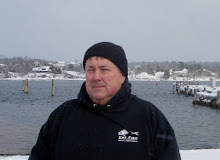 | ||
| HORSES HARVESTING IRISH MOSS ON PEI |
A long time ago I spent a summer in Rockland, Maine living on Lurmonds Cove. If that sounds familiar, its because the cove had a recent brush with fame when a schooner went aground there a couple of years ago. Back then I shared the cove with the Rockland waste water plant, the Maine State Ferry Service and Marine Colloids. The latter occupied the shore opposite me and is notable in my memory for lots of lights at night, for a constant low humming sound and for the stack pushing out clouds of vapor. On foggy nights the lights and vapor combined to create an industrial tableaux reminiscent of an impressionist painting.
I soon learned I was living across from a plant that processed Irish moss into the very valuable product additive, carageenan. Irish moss got named for the people of County Carrageenan, Ireland who used to collect it to make pudding. It got valuable when people started to use it as a binder, thickener and stabilizer in things like ice cream, beer, toothpaste, pharmaceuticals, diet soda and a host of other products.
In Rockland the lowly moss (chrondrus crispus) was cooked down and dried out to a powder and sold as an additive for pharmaceuticals. It was and is valuable. I knew some people on the supply side of the business who made a living raking the moss and selling it to Marine Colloids, which was called Sea Pro back then. It was a small investment for the harvesters, a rake or drag, a $50 permit and a wonky tin skiff and they were in business. It was a low overhead operation. Like clammers, they had a minimal investment in equipment (compared with say a lobster catcher) and an heroic investment in hard labor to make a living. Working along the tide line at low tide they harvested the moss by raking it up. It was then transported to the plant. Processing smelled pretty bad and what remained afterwards left the cove by the truck load headed for the old quarry that served as the dump.
I didn't think much about the Irish moss-carageenan connection until I saw moss being harvested with horses on Prince Edward Island a couple of weeks ago. At the time I was struck by the contrast between the horses and harvesters gathering moss and the wind turbine farm on the bluff above harvesting energy for the island. The juxtaposition of horse power of the past and wind power turbines looking toward the future has stayed with me. Yesterday I went through my trip photos and found some still images and a scrap of video of harvesters working their horses along the surf line. I was pretty far away, but here it is anyway. There's more about harvesting moss at the Harvests of Prince Edward Island page.















